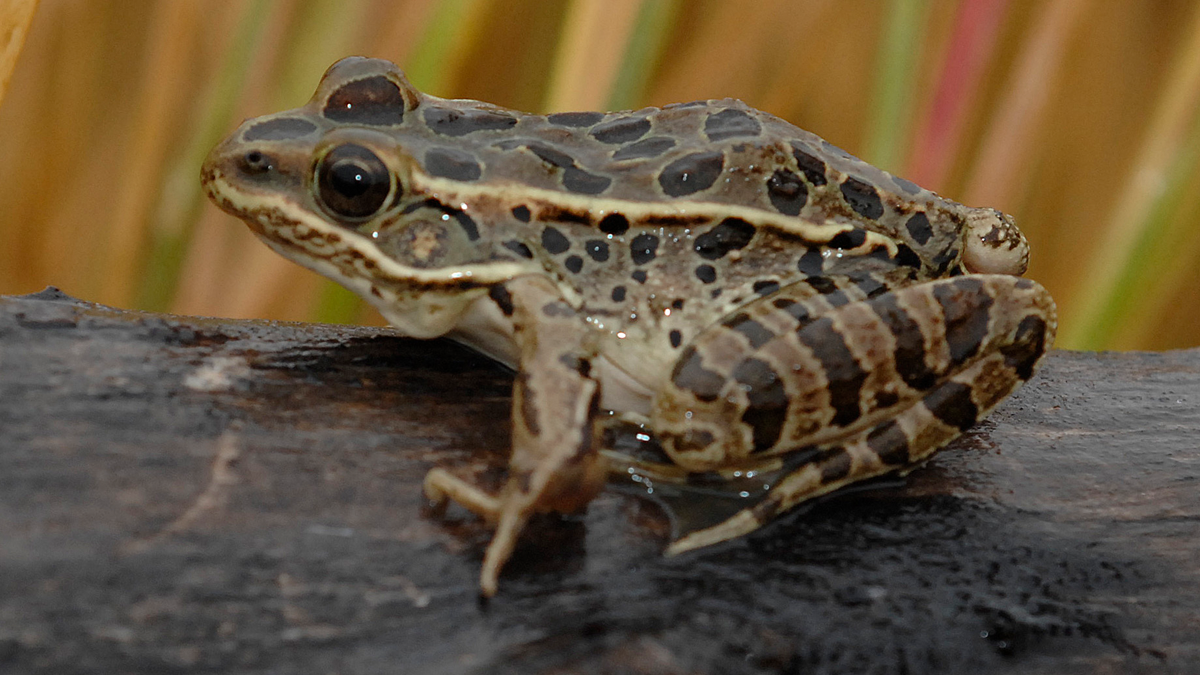Overview
Amphibians are small, cold-blooded vertebrates, including frogs, toads and salamanders, that are typically found in moist environments such as wetlands. Many amphibians start as aquatic larvae and develop into semi-terrestrial adults that can inhabit both aquatic and terrestrial habitats.
Major threats to amphibian species include habitat loss and fragmentation, including loss of breeding and upland habitat. Other threats include road mortality during migrations to and from breeding habitats, fish stocking, pollution and diseases. Drought can also pose a local and periodic threat.
Some amphibians have naturally low maturation and reproduction rates, which may further increase their susceptibility to external threats.
Use keyboard or mouse to scroll through the gallery
General status
In 2020, 10 native amphibian species, including 8 species of frogs and toads and 2 salamander species, were included in the Alberta general status (see Figures 1 and 2):
- Three amphibian species (30%) were ranked secure:
- Barred Tiger Salamander (Ambystoma mavortium)
- Boreal Chorus Frog (Pseudacris maculata)
- Wood Frog (Lithobates sylvatica)
- Four amphibians (40%) were ranked sensitive:
- Columbia Spotted Frog (Rana luteiventris)
- Great Plains Toad (Anaxyrus cognatus)
- Long-toed Salamander (Ambystoma macrodactylum)
- Western Toad (Anaxyrus boreas)
- Two amphibians (20%) were ranked may be at risk:
- Canadian Toad (Anaxyrus hemiophrys)
- Plains Spadefoot (Spea bombifrons)
- One species (10%) was ranked at risk: Northern Leopard Frog (Lithobates pipiens).
Great plains toad (Anaxyrus cognatus) is the only amphibian species with a change in status over the last 20 years; its status improved from ‘may be at risk’ to ‘sensitive’ in 2015.
Among all vertebrate groups in Alberta, amphibians have the largest proportion of species ranked ‘at risk’ and ‘may be at risk’ (30%).
Detailed status
As of January 2024, 4 amphibian species have detailed status designations including one listing under Alberta’s Wildlife Act:
- Northern Leopard Frog (Lithobates pipiens) is designated as Threatened under the Wildlife Act.
- Great Plains Toad (Anaxyrus cognatus) and Long-toed Salamander (Ambystoma macrodactylum) have a detailed status of Special Concern.
- Canadian Toad (Anaxyrus hemiophrys) has a detailed status of Data Deficient.
Resources
- Amphibian Identification (Alberta Conservation Association)
- Alberta Volunteer Amphibian Monitoring Program (AVAMP)
- Alberta FrogWatch
- ABMI Biodiversity Browser Amphibians
Charts
Figure 1. Number of native amphibian species and their general status ranks in Alberta between 2000 and 2020
Chart data table
| Year | Secure | Sensitive | May be at risk | At risk |
|---|---|---|---|---|
| 2000 | 3 | 3 | 3 | 1 |
| 2005 | 3 | 3 | 3 | 1 |
| 2010 | 3 | 3 | 3 | 1 |
| 2015 | 3 | 4 | 2 | 1 |
| 2020 | 3 | 4 | 2 | 1 |
Accessible chart description
Stacked bar graph showing the general status ranks of Alberta’s 10 native amphibians over time in 5-year intervals from 2000 until the latest assessment in 2020. In 2020, 3 amphibian species (30%) were ranked secure, 4 amphibians (40%) were ranked sensitive, 2 amphibians (20%) were ranked may be at risk and one species (10%) was ranked at risk. Only one species changed its status over the last 20 years: Great plains toad had an improved status from ‘may be at risk’ to ‘sensitive’ in 2015.
Figure 2. Proportion of general status ranks for Alberta’s native amphibians in 2020
Chart data table
| General status rank | 2020 |
|---|---|
| Secure 30% | 3 |
| Sensitive 40% | 4 |
| May be at risk 20% | 2 |
| At risk 10% | 1 |
Accessible chart description
Pie chart showing the proportion of general status ranks for Alberta’s 10 native amphibian species in 2020. Total number of amphibian species and the respective percentage are provided for each general status rank. 3 amphibian species (30%) were ranked secure, 4 amphibians (40%) were ranked sensitive, 2 amphibians (20%) were ranked may be at risk and one species (10%) was ranked at risk in 2020.

